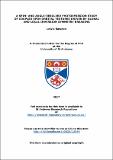Files in this item
A spin- and angle-resolved photoemission study of coupled spin-orbital textures driven by global and local inversion symmetry breaking
Item metadata
| dc.contributor.advisor | King, Phil | |
| dc.contributor.author | Bawden, Lewis | |
| dc.coverage.spatial | 160 | en_US |
| dc.date.accessioned | 2017-11-10T12:46:44Z | |
| dc.date.available | 2017-11-10T12:46:44Z | |
| dc.date.issued | 2017-09-21 | |
| dc.identifier.uri | https://hdl.handle.net/10023/12049 | |
| dc.description.abstract | The effect of spin-orbit coupling had once been thought to be a minor perturbation to the low energy band structure that could be ignored. Instead, a surge in recent theoretical and experimental efforts have shown spin-orbit interactions to have significant consequences. The main objective of this thesis is to investigate the role of the orbital sector and crystal symmetries in governing the spin texture in materials that have strong spin-orbit interactions. This can be accessed through a combination of spin- and angle-resolved photoemission spectroscopy (ARPES and spin-ARPES), both of which are powerful techniques for probing the one-electron band structure plus interactions, and supported by density functional theory calculations (DFT). We focus first on a globally inversion asymmetric material, the layered semiconductor BiTeI, which hosts a giant spin-splitting of its bulk bands. We show that these spin-split bands develop a previously undiscovered, momentum-space ordering of the atomic orbitals. We demonstrate this orbital texture to be atomic element specific by exploiting resonant enhancements in ARPES. These orbital textures drive a hierarchy of spin textures that are then tied to the constituent atomic layers. This opens routes to controlling the spin-splitting through manipulation of the atomic orbitals. This is contrasted against a material where inversion symmetry is globally upheld but locally broken within each monolayer of a two layer unit cell. Through our ARPES and spin-ARPES measurements of 2H-NbSe₂, we discover the first experimental evidence for a strong out-of-plane spin polarisation that persists up to the Fermi surface in this globally inversion symmetric material. This is found to be intrinsically linked to the orbital character and dimensionality of the underlying bands. So far, previous theories underpinning this (and related) materials’ collective phases assume a spin-degenerate Fermi sea. We therefore expect this spin-polarisation to play a role in determining the underlying mechanism for the charge density wave phase and superconductivity. Through these studies, this thesis then develops the importance of global versus local inversion symmetry breaking and uncovers how this is intricately tied to the underlying atomic orbital configuration. | en_US |
| dc.language.iso | en | en_US |
| dc.publisher | University of St Andrews | |
| dc.subject | Angle-resolved photoemission spectroscopy (ARPES) | en_US |
| dc.subject | Spin-and angle-resolved photoemission spectroscopy (Spin-ARPES) | en_US |
| dc.subject | Hard condensed matter experiment | en_US |
| dc.subject | Spin-orbit interaction | en_US |
| dc.subject | Spin-polarisation | en_US |
| dc.subject | Atomic orbital character | en_US |
| dc.subject | Electronic structure | en_US |
| dc.subject | Tight binding | en_US |
| dc.subject | Inversion symmetry | en_US |
| dc.subject | Rashba spin-orbit | en_US |
| dc.subject | Transition metal dichalcogenide | en_US |
| dc.subject.lcc | QC176.8E4B28 | |
| dc.subject.lcsh | Atomic orbitals | en |
| dc.subject.lcsh | Energy bands | en |
| dc.subject.lcsh | Emission spectroscopy | en |
| dc.subject.lcsh | Photoemission | en |
| dc.title | A spin- and angle-resolved photoemission study of coupled spin-orbital textures driven by global and local inversion symmetry breaking | en_US |
| dc.type | Thesis | en_US |
| dc.type.qualificationlevel | Doctoral | en_US |
| dc.type.qualificationname | PhD Doctor of Philosophy | en_US |
| dc.publisher.institution | The University of St Andrews | en_US |
This item appears in the following Collection(s)
Items in the St Andrews Research Repository are protected by copyright, with all rights reserved, unless otherwise indicated.

